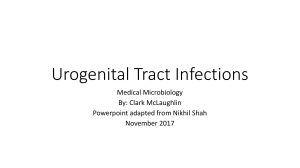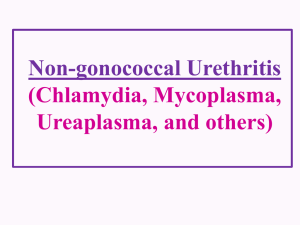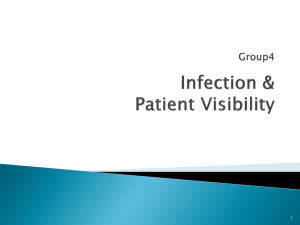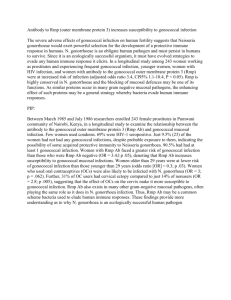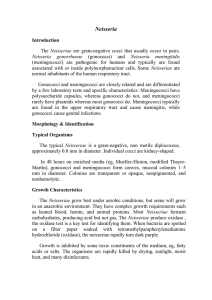Neisseria gonorrhoeae file
advertisement
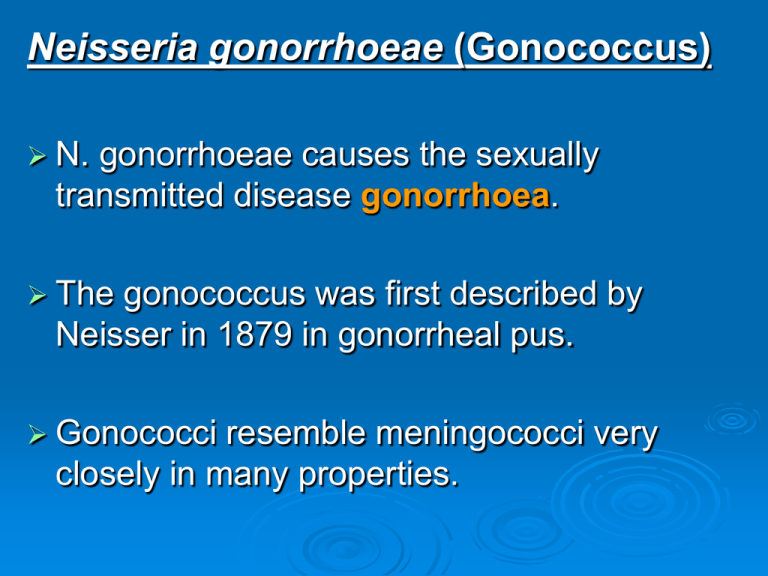
Neisseria gonorrhoeae (Gonococcus) N. gonorrhoeae causes the sexually transmitted disease gonorrhoea. The gonococcus was first described by Neisser in 1879 in gonorrheal pus. Gonococci resemble meningococci very closely in many properties. MORPHOLOGY: Gram negative diplococci with adjacent sides concave, being typically kidney shaped. They are usually found with in the polymorphs. They possess pili on their surface. CULTURE & CULTURAL CHARACTERISTICS: Gonococci are fastidious organisms do not grow on ordinary culture media. They are aerobic but may grow anaerobically also. The optimum temperature for growth is 35-36°C & optimum pH is 7.2-7.6. It is essential to provide 5-10% CO2. Media used: a) Non selective media: Chocolate agar, Mueller-Hinton agar. b) Selective media: Thayer Martin medium with antibiotics (Vancomycin, Colistin & Nystatin. Colony morphology: Colonies are small, round, translucent, convex or slightly umbonate with finely granular surface & lobate margins. Biochemical reactions: 1) Oxidase test: Positive 2) Ferments only glucose but not maltose. PATHOGENICITY: Source of infection: 1. Asymptomatic carriers 2. Patients Mode of infection: 1. Venereal infection (sexual contact) 2. Nonvenereal infection Antigenic structure & virulence factors: 1. Pili: They help in adherence of bacteria to host epithelial cells & they are antiphagocytic. 2. Lipooligosaccharide: Endotoxic. 3. Outer membrane proteins: 3 types a) Protein I (por)- it is a porin & helps in adherence. b) Protein II (opa)- helps in adherence. c) Protein III (rmp)- it is associated with protein I. 4. IgA1 protease: Splits & inactivates IgA. Antigenic structure & virulence factors Mechanism of pathogenesis: Gonococci adhere to epithelial cells of urethra or other mucosal surface through pili Cocci penetrate through the intercellular space They reach the sub epithelial connective tissue & causes inflammation Leads to clinical manifestations Incubation period: 2-8 days. Disease: A) In men: The disease starts as an acute urethritis with a mucopurulent discharge The infection extends to the prostate, seminal vesicles & epididymis In some it may become chronic urethritis leading to stricture formation The infection may spread to the periurethral tissues, causing abscesses & multiple discharging sinuses (Watercan perineum) B) In women: The initial infection is urethritis & cervicitis but vaginitis does not occur in adult female (vulvovaginitis can occur in prepubertal girls) The infection may extend to Bartholin’s glands, endometrium & fallopian tubes causing Pelvic Inflammatory Disease (PID) Rarely peritonitis may develop with perihepatic inflammation (Fitz-Hugh-Curtis syndrome) C) In both the sexes: Proctitis, pharyngitis, conjunctivitis, bacteraemia which may lead to metastatic infection such as arthritis, endocarditis, meningitis, pyemia & skin rashes. D) In neonates: Opthalmia neonatorum (a nonvenereal gonococcal conjunctivitis in the newborn) results from direct infection during passage through birth canal. LABORATORY DIAGNOSIS: Specimens collected: A) In men: a) Acute infection- Urethral discharge b) Chronic infectioni) Morning drop ii) Discharge collected after prostatic massage iii) Centrifuged deposit of urine B) In women: i) ii) Urethral discharge Cervical swabs C) In both the sexes: Blood, CSF, synovial fluid, throat swab, rectal swab & material from skin rashes. Transport: If there is delay in processing than the specimens should be sent in “ Stuart’s medium”. Methods of examination: A) Direct microscopy: 1. Gram staining: Smear provides a presumptive evidence of gonorrhea in men. Gram negative diplococci are found. But it is unreliable in women. 2. Immunofluorescence: B) Culture: Media used: Colony morphology: Gram’s smear: Reveals Gram negative cocci in pairs with adjacent sides concave. Biochemical reactions: C) Serology: Complement fixation test, Precipitation, Passive agglutination, Immunofluorescence, Radioimmunoassay. TREATMENT: Previously Penicillin was drug of choice but resistance developed rapidly. Penicillin resistant is due to production of penicillinase enzyme & the strains are called as penicillinase producing Neisseria gonorrhoeae (PPNG). Now Ceftriaxone or Ciprofloxacin plus Doxycycline or Erythromycin is useful. EPIDEMIOLOGY: Gonorrhoea is an exclusively human disease. The only source of infection is a human carrier or less often a patient. Asymptomatic carriage in women makes them a reservoir to spread infection among their male contact. Gonorrhoea is an venereal disease (STD). PROPHYLAXIS: Early detection of cases, Tracing Health of contacts, education, General measures, Vaccination has no role in prophylaxis. NONGONOCOCCAL (NONSPECIFIC) URETHRITIS Urethritis due to causative agents other than gonococcus. Etiology: a) Bacteria- Chlamydia trachomatis Mycoplasma urealyticum Ureaplasma urealyticum b) Parasites- Trichomonas vaginalis c) Viruses- Herpes simplex Cytomegalovirus d) Fungi- Candida NGU can be a part of Reiter’s syndrome- a clinical condition characterized by urethritis, arthritis & conjunctivitis. THANK YOU




